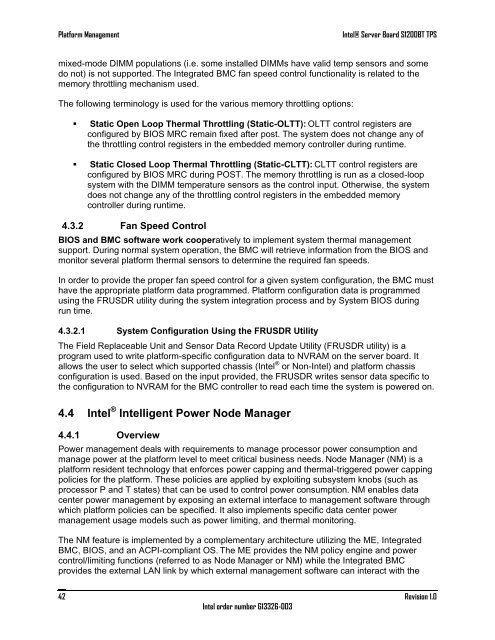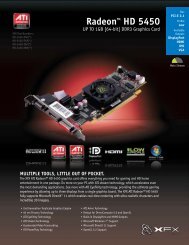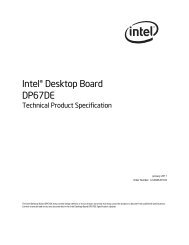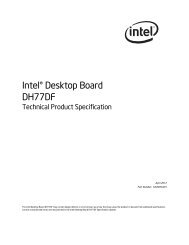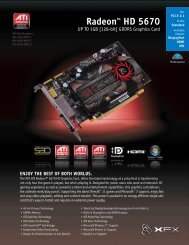Intel Server Board S1200BT - PROconsult Data A/S
Intel Server Board S1200BT - PROconsult Data A/S
Intel Server Board S1200BT - PROconsult Data A/S
Create successful ePaper yourself
Turn your PDF publications into a flip-book with our unique Google optimized e-Paper software.
Platform Management<br />
<strong>Intel</strong>® <strong>Server</strong> <strong>Board</strong> <strong>S1200BT</strong> TPS<br />
mixed-mode DIMM populations (i.e. some installed DIMMs have valid temp sensors and some<br />
do not) is not supported. The Integrated BMC fan speed control functionality is related to the<br />
memory throttling mechanism used.<br />
The following terminology is used for the various memory throttling options:<br />
• Static Open Loop Thermal Throttling (Static-OLTT): OLTT control registers are<br />
configured by BIOS MRC remain fixed after post. The system does not change any of<br />
the throttling control registers in the embedded memory controller during runtime.<br />
• Static Closed Loop Thermal Throttling (Static-CLTT): CLTT control registers are<br />
configured by BIOS MRC during POST. The memory throttling is run as a closed-loop<br />
system with the DIMM temperature sensors as the control input. Otherwise, the system<br />
does not change any of the throttling control registers in the embedded memory<br />
controller during runtime.<br />
4.3.2 Fan Speed Control<br />
BIOS and BMC software work cooperatively to implement system thermal management<br />
support. During normal system operation, the BMC will retrieve information from the BIOS and<br />
monitor several platform thermal sensors to determine the required fan speeds.<br />
In order to provide the proper fan speed control for a given system configuration, the BMC must<br />
have the appropriate platform data programmed. Platform configuration data is programmed<br />
using the FRUSDR utility during the system integration process and by System BIOS during<br />
run time.<br />
4.3.2.1 System Configuration Using the FRUSDR Utility<br />
The Field Replaceable Unit and Sensor <strong>Data</strong> Record Update Utility (FRUSDR utility) is a<br />
program used to write platform-specific configuration data to NVRAM on the server board. It<br />
allows the user to select which supported chassis (<strong>Intel</strong> ® or Non-<strong>Intel</strong>) and platform chassis<br />
configuration is used. Based on the input provided, the FRUSDR writes sensor data specific to<br />
the configuration to NVRAM for the BMC controller to read each time the system is powered on.<br />
4.4 <strong>Intel</strong> ® <strong>Intel</strong>ligent Power Node Manager<br />
4.4.1 Overview<br />
Power management deals with requirements to manage processor power consumption and<br />
manage power at the platform level to meet critical business needs. Node Manager (NM) is a<br />
platform resident technology that enforces power capping and thermal-triggered power capping<br />
policies for the platform. These policies are applied by exploiting subsystem knobs (such as<br />
processor P and T states) that can be used to control power consumption. NM enables data<br />
center power management by exposing an external interface to management software through<br />
which platform policies can be specified. It also implements specific data center power<br />
management usage models such as power limiting, and thermal monitoring.<br />
The NM feature is implemented by a complementary architecture utilizing the ME, Integrated<br />
BMC, BIOS, and an ACPI-compliant OS. The ME provides the NM policy engine and power<br />
control/limiting functions (referred to as Node Manager or NM) while the Integrated BMC<br />
provides the external LAN link by which external management software can interact with the<br />
42<br />
<strong>Intel</strong> order number G13326-003<br />
Revision 1.0


